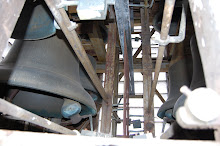By Andrew Lagassé
From behind the row of turnbuckles and metal rods, David Maker thumps the batons of the aging carillon. Each smack of his fist makes a harsh slapping sound, followed by the resonating toll of a bell overhead.
The bells are part of the University of Connecticut’s carillon, and Maker is a professor of music and a carillonneur.
The 31 bronze alloy bells, collectively weighing 15,500 pounds, are owned and maintained by the university, but housed in Storrs Congregational Church. According to Maker, this is the only carillon publicly owned but installed on private property.
In 1931, through the generosity of Austin Cornelius Dunham, the carillon was donated to the university. It was inaugurated on June 6, 1931, the university’s 50th anniversary.
The UConn carillon is one of 11 carillons in Connecticut, and one of only a half-dozen carillons made entirely in the United States, according to Maker.
Col. Benjamin Hanks, whose foundry stood not two miles from campus in the early 1800s, was the first maker of church bells in the United States. His son’s apprentice, Andrew Meneely, created the Old Meneely Bell Co. in Watervliet, N.Y. The Storrs carillon came from the Meneely firm.
In some towns, the bells are regarded as a nuisance. “The carillon bells at Yale University are hated by the townspeople, so they have rules for when the bells can be played,” said Maker.
In other communities such as Simsbury and Storrs there are no limitations on using the carillon.
To reach the UConn carillon, one must climb up two flights of stairs inside the church. Here, the clock mechanism resides. A level below the carillon, this contraption looks like something out of a storybook. At each quarter hour the machine whirrs and whistles, gears turning, levers spinning, all of this to produce a simple song to sound the passing of time.
Two steep ladders in the church tower lie between the clock mechanism and the carillon, an instrument much less sophisticated than the piece of clock equipment below.
A single fluorescent bulb is enough light to fill the room. The wooden keyboard is composed of keys, called batons, that look like chair legs. The foot pedals jut from the bottom of the carillon. The entire wooden instrument is connected to slender metal rods that shoot up to the ceiling, like the strings of a puppet.
Above, the bronze clappers clang their notes as Maker pounds the tired batons. Every punch of the keyboard threatens to knock out the carillon for good, but the carillon continues to play the notes demanded by the carillonneur.
Such bells in the past were once used as a broadcast system, and also to determine the boundaries of a town. If a person was within earshot of the bells, then they were considered to still be in the town limits.
University officials intended to use the carillon as a passing bell, but their use as such was short lived.
A single file cabinet contains the entire library of carillon sheet music. According to Maker, there is not an abundance of music written specifically for the carillon.
Today, the carillon is worn from decades of use, and is in need of repair. Maker is optimistic that repairs will be made. “We want to start an account for donations,” said Maker. “I have no idea how soon it would be repaired.”
Tuesday, May 12, 2009
Subscribe to:
Post Comments (Atom)

No comments:
Post a Comment